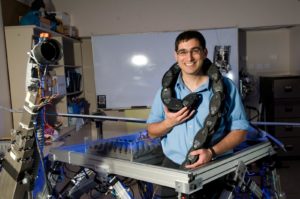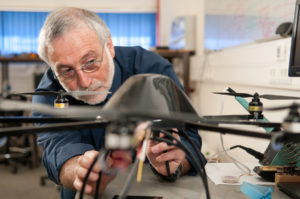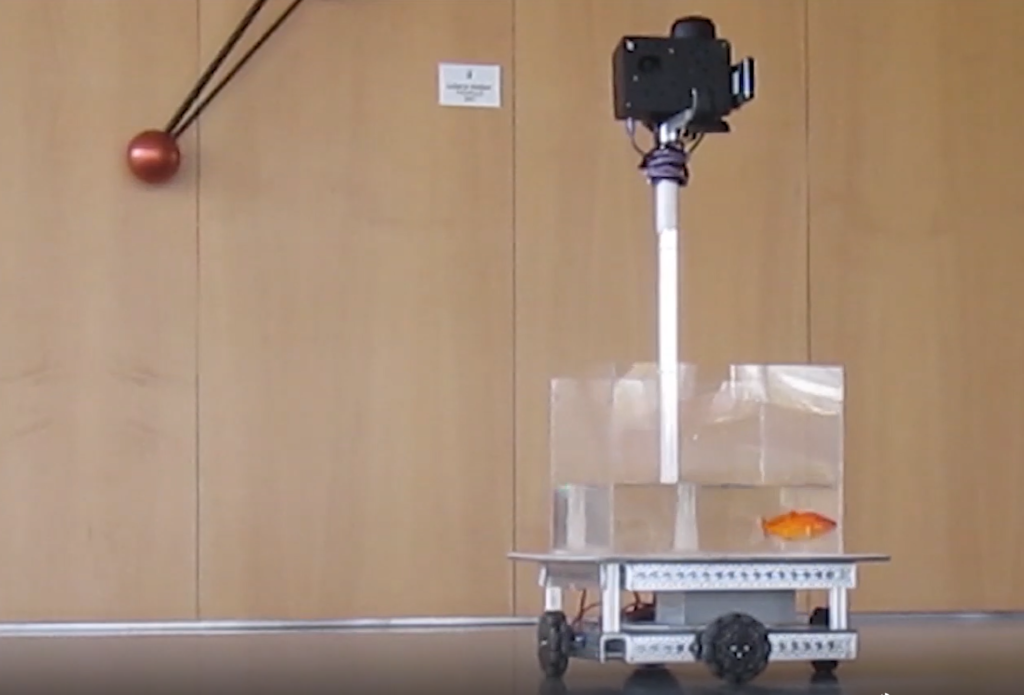
The Many Robots of BGU
March 14, 2014
Jewish Business News — If you ask Dr. Amir Shapiro, director of BGU’s Robotics Lab in the University’s Department of Mechanical Engineering, to explain what a robot is, he’ll point at the phrase decorating the lab walls: “If you don’t want to do something, a robot will do it for you.”
Dangerous, dirty, boring jobs? No problem, a robot could do all of them: Descending into sewers, entering a failing nuclear reactor, exploring dark tunnels on the Gaza border, spraying pesticides – robots will soon be able to carry out all these and more.
In the University’s two robotics labs, run by Dr. Amir Shapiro and Prof. Hugo Guterman, you realize that when it comes to robotics the sky’s the limit.
Drones, jeeps, submarines, ATVs, serpentine robots, robots that carry gear for soldiers, robots that help the elderly and pick apples – all unmanned, autonomous and fascinating. Robotics, according to the two robotics directors and their students, is the future, and it’s already here.
“In this lab we develop our own projects or custom projects for clients. We build prototypes, design and build working models – their mechanics, electronics, software, algorithms – It’s all done right here, in-house,” explains Dr. Shapiro.
“After the prototype phase, we begin looking for a sponsor who will fund the rest of the development process.”
An example of a robot being developed in Dr. Shapiro’s lab is a micro-robot for Israel’s Ministry of Defense. It’s a black box the size of a cellphone, basically a tiny, two-wheeled antenna. Soldiers carry the robot along with the rest of their combat gear.
When the unit is about to enter a suspicious residence, for example, the robot is activated and sent into the building. The soldier carries a tiny monitor strapped to his left arm, displaying whatever the robot’s camera sees: Doors, furniture, balconies, and people. The robot can maneuver inside tunnels and it can also carry cameras, sensors, laser pointers, all according to mission requirements.
Prof. Hugo Guterman, of BGU’s Department of Electrical and Computer Engineering, is the founder and director of the University’s Laboratory for Autonomous Robotics one of the only labs in the academic world that builds complete robotics systems from A to Z.
“The robotics programs of today are advanced and sophisticated. They give robots the ability to make decisions. If a robot comes across an unfamiliar situation, it will still know how to decide what to do. Its software gives it a set of rules, although the robot may still come across situations with changing rules, says Prof. Guterman.
“A well known example is a person driving a vehicle, waiting for the traffic light to change from red to green, when an ambulance arrives. What should the driver do? Will he follow the law and wait until the light turns green, or will he move and allow the ambulance to pass by?
“How will an autonomous vehicle react? The robot is programmed to stop at a red light, but the arrival of the ambulance breaks the rules. This is one of the challenges facing researchers of advanced robotics. However, robots never get tired or bored, and can repeat the same action millions of times without complaining.”
An example of a robot built in Prof. Guterman’s lab is the first Israeli-built submarine which was designed by students for a robotics competition abroad.
It is some 5 feet long (1.5 m) long and can cruise, float in place, descend, and rise. It has a load-bearing arm and a camera. The submarine is made of composite materials. It is powered by six small engines and can reach a depth of 230 feet (70 m). The next version will be able to reach a depth of 985 feet (300 m).
Applications? Everything is fair game: From mapping corral reefs and inspecting ships from underneath to guarding oil fields.
“These type of underwater vehicles can remain underwater for 24 hours: Guarding large ports, aiding ship-cleaning efforts, and checking suspicious ships,” explains Guterman.
Read more of this article by Dan Arkin on the Jewish Business News website >>





